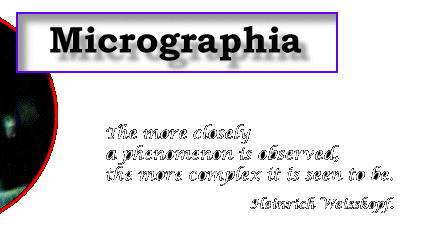 Micrographia Site Directory.
Micrographia Site Directory.
|
 Home Page.
Home Page.
|
The Home button on the navigation bar at the top of each
page will return you here -- you can then access any area of
the site from the links in this directory. Other buttons on the
bar will take you directly to the main site areas.
An email link is provided at the bottom of each page for comments and enquiries.
|
 New Material.
New Material.
 Last updated 04/08/2005.
Last updated 04/08/2005.
|
 Two green bullets indicate the most recently uploaded material.
Two green bullets indicate the most recently uploaded material.
 A blue bullet indicates a link to an external website which will open in a new browser window. Quitting the window will return you instantly to Micrographia. A blue bullet indicates a link to an external website which will open in a new browser window. Quitting the window will return you instantly to Micrographia.
|
 Feature Picture.
Feature Picture.
|
A galaxy of oil-exuding airborne particles which have settled on an exposed microscope eyepiece -- and an unexpectedly interesting exercise in image interpretation for the microscopist.
|
 Editorial and Comment.
Editorial and Comment.
|
Micrographia site news, recent and current events in
science and microbiology, plus anything else deemed relevant.
|
 Articles.
Articles.
|
A considered selection of articles, culled from various
sources, most likely to be of interest to users of the microscope in particular, and to those curious about Life on Earth in general.
|
 Specimen Gallery Directory.
Specimen Gallery Directory.
|
The Specimen Galleries are a major part of the site.
The directory groups biological specimens according to physical features and habitat, and non-biological specimens by subject.
Intended for those needing to identify creatures and objects seen under the microscope, as well as for the casual browser.
|
 Tutorials. Directory.
Tutorials. Directory.
 Using the Microscope.
Using the Microscope.
 Basic Tutorial.
Basic Tutorial.
-
Brightfield.
Introduction to Köhler Illumination.
Microscopy with Minimal Equipment.
 Advanced Tutorials.
Advanced Tutorials.
- Brightfield.
- Darkfield.
- Phase Contrast.
- Incident Illumination.
- Measurement with the Microscope.
|
Basic instruction on using Köhler illumination with a laboratory grade microscope. Gives practical advice as well as a brief account of the theory of image formation.
Preparatory reading for those interested in the advanced tutorials.
Advanced Tutorials.
Detailed accounts of the principal imaging and illumination systems of the light microscope, with practical instruction.
(All still in preparation).
|
 Projects and Applications.
Projects and Applications.
|
This section deals with the application of the light microscope to
particular tasks, and the ways in which standard microscope components (and special items as required) can be combined to image particular specimens.
Also covered are the associated problems of specimen manipulation.
|
 Archive.
Archive.
- Past Micrographia Articles.
- Past Contributor's Articles.
- Correspondence.
-
Reference sources.
|
An indexed listing of past articles on all subjects, including those from contributing authors. Details on books and other reference sources used by Micrographia.
|
 Suppliers.
Suppliers.
|
Microscope sales, suppliers of related materials.
|
 Links to Related Web Sites.
Links to Related Web Sites.
|
A tried and tested collection of Web sites rewarding to microscopists and all aficionados of the miniscule.
|







